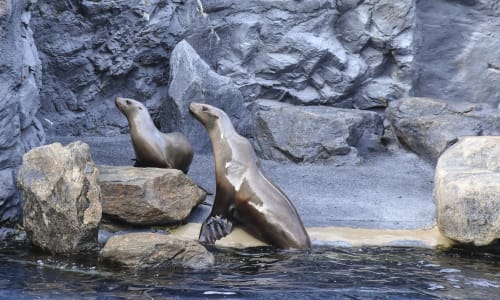
The Power of Conservation: Celebrating 50 Years of the Endangered Species Act and Mystic Aquarium
October 26, 2023By Erica Casper
This year marks not only the 50th anniversary of Mystic Aquarium, but also the 50th anniversary of the Endangered Species Act (ESA). Let’s take a moment to acknowledge the critical role that the ESA has played in preserving our planet's unique and diverse tapestry of life, including the remarkable success stories of Mystic Aquarium's ongoing conservation efforts.

The ESA: A Beacon of Hope for Wildlife
The ESA was enacted in 1973 to protect animals and plants on the brink of extinction. Under this act, species can be classified as either "endangered" or "threatened." "Endangered" means a species is teetering on the edge of extinction, while "threatened" implies it's at risk of becoming endangered in the foreseeable future.
Two governmental agencies, the U.S. Fish and Wildlife Service (FWS) and the U.S. National Oceanic and Atmospheric Administration (NOAA) Fisheries Service, play a crucial role in ensuring the ESA's objectives are met. NOAA Fisheries takes responsibility for most marine species, while FWS is responsible for terrestrial and freshwater species, as well as marine mammals, including walruses, sea otters, manatees, and polar bears. Together, they share authority over various other species, such as sea turtles, Gulf sturgeon, and Atlantic salmon.
A Lifeline for Struggling Species
The FWS maintains a comprehensive list of species from across the globe that face the specter of extinction. This list includes mammals, birds, fish, reptiles, invertebrates, and plants. Once a species finds its place on this list, it's granted legal protection and specific conservation measures are set in motion to ensure its survival and recovery. Over 1,700 species are currently under the ESA's, including both domestic and foreign species.
Including foreign species on the list isn't just an act of goodwill; it also imposes prohibitions on certain activities like import, export, take, commercial activity, interstate commerce, and foreign commerce. This helps curb illegal trafficking of endangered species and encourages international cooperation in wildlife conservation.

Key Provisions of the ESA
The ESA comes equipped with several key provisions to protect our planet's most imperiled inhabitants. These include:
- Listing species: Identifying and categorizing species as endangered or threatened.
- Designating critical habitats: Identifying and safeguarding areas crucial for the survival and recovery of listed species.
- Prohibiting harmful actions: Preventing activities that could harm listed species.
- Developing recovery plans: Crafting detailed strategies for the restoration of species facing extinction.
- Restricting trade: Prohibiting the import, export, sale, or trade of listed species.
- Enforcing penalties: Ensuring accountability and imposing penalties for those who violate the ESA's provisions.
Success Stories and the Mystic Aquarium Connection
The ESA has achieved remarkable successes in its 50-year journey. Icons of conservation, like the bald eagle, peregrine falcon, and gray wolf, are proof that the act works. Remarkably, more than 99% of species listed have avoided extinction, and more than 100 species of animals and plants have been de- or downlisted due to recovery. Hundreds more are stable or improving.
Mystic Aquarium takes pride in caring for a living testament to the ESA's triumphs. Steller sea lions, specifically the Eastern distinct population segment, were listed as threatened under the ESA almost a quarter-century ago. Through targeted conservation efforts and dedication, this population of Steller sea lions has made a remarkable recovery and has been removed from the list. It's a testament to the power of conservation, showing that species can rebound when we stand up for their protection.

A Wake-Up Call for Species Protection
Despite the ESA’s successes, too many species remain in danger of extinction. Although the Eastern distinct population of Steller sea lions is thriving, the Western distinct population segment is still on the ESA's list of endangered species. Furthermore, the FWS is delisting 21 species from the ESA due to extinction. These setbacks serve as a reminder of the ongoing challenges and highlight the importance of continued conservation efforts before it’s too late.
Looking to the Future
As we celebrate the 50th anniversary of the ESA and Mystic Aquarium, we acknowledge the critical role we all play in preserving our planet's future. It's a reminder that when we come together to protect the natural world, we can achieve incredible things.
The ESA's significance extends far beyond individual species; it's a lifeline for preserving biodiversity. Healthy ecosystems depend on the intricate web of life, and the ESA plays a crucial role in maintaining this balance. It's a safeguard against the domino effect that can occur when one species disappears, affecting the entire ecosystem.
The ESA is not just a piece of legislation; it's a lifeline for our planet's future, and it's up to all of us to ensure it remains strong for the next 50 years and beyond.